Apples and Oranges: An interview with Yael Ben-Zion
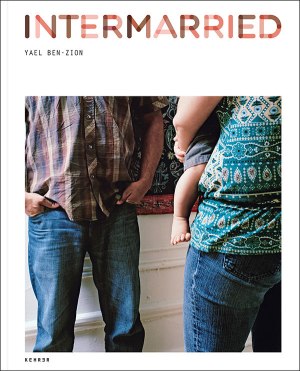 “I was wondering maybe could I make you my baby/If we do the unthinkable would it make us look crazy?” Alicia Keys sings in her 2010 hit song Unthinkable (I’m Ready). In the accompanying music video, Keys acts out two dramas in different eras, both of which involve an African-American woman trying to decide if she’s bold enough to date a white man.
“I was wondering maybe could I make you my baby/If we do the unthinkable would it make us look crazy?” Alicia Keys sings in her 2010 hit song Unthinkable (I’m Ready). In the accompanying music video, Keys acts out two dramas in different eras, both of which involve an African-American woman trying to decide if she’s bold enough to date a white man.
It says something about our culture that, even in 2010, a music video characterized an interracial relationship as “unthinkable.” In fact, interracial relationships and intermarriage are on the rise, in the United States and elsewhere. According to a 2012 survey by the Pew Research Center, about 15% of all new marriages in the U.S. in 2010 were between spouses of a different race or ethnicity from one another, compared to 6.7% in 1980. Yet in popular culture, intermarriage is still—if not unthinkable—largely untouchable. Last year, a television commercial for Cheerios featuring a racially mixed family drew such ire on the General Mills YouTube channel that, under public pressure, the cereal giant took all the comments down and disabled any further comments.
Five years ago, New York-based photographer Yael Ben-Zion became aware of another advertising campaign, this one from her native Israel. The controversial commercial (below), put out by a joint Israeli government-nonprofit organization called Masa Israel, warned diaspora Jews against the dangers of intermarriage and assimilation. Shot in empty train stations and on bleak, abandoned roads, it carried an air of despair and the message that intermarried Jews were “lost” to Israel.
At the time, Ben-Zion was working on a book called 5683 Miles Away, about how it felt to be a non-resident observing her homeland (5,683 miles is the distance between New York City and Tel Aviv). But the Masa Israel advertisement intrigued and riled her, especially as a Jew who’d “married out.” So that year, she embarked on a project to photograph families in her ethnically diverse neighborhood of Washington Heights. Placing an ad on an online parenting group for her neighborhood, she left it to the families to decide on their own definition of “mixed,” hoping she’d get a variety of racial and religious intermarriages.
The result, four years later, is Intermarried, Ben-Zion’s second monograph. Delicate and nuanced, the book eschews straight portraiture, instead depicting the subtleties in couples’ relationships through small gestures and environmental details. A golden Nepalese deity statue shares space with a set of woven African baskets; a photo triptych depicts a black woman, a white man, and their mixed race child in the middle. Four hands, on a kitchen table, work together on their mutual passion, furniture design.
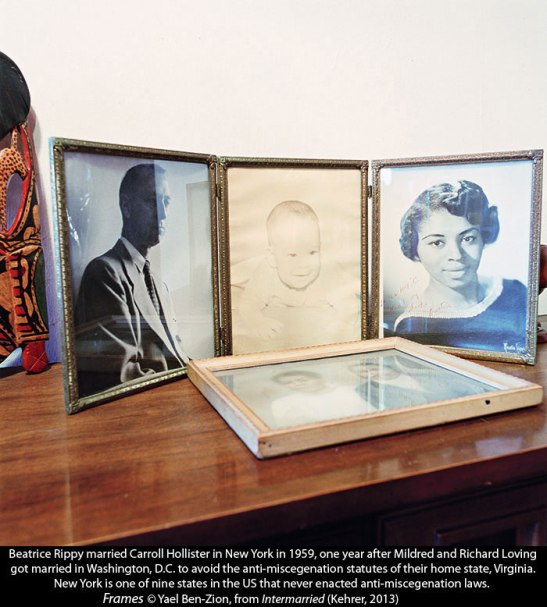 “I don’t have an agenda… I’m not trying to promote intermarriage, I just wanted to spark a discussion,” says Ben-Zion, who quit a career as a corporate lawyer in order to become a photographer. Along with its images, the book is full of interesting words: there are quotes from the pictured couples about the pros and cons of intermarriage, and text from a 1921 doctoral thesis about intermarriage in America. There is also a fascinating portrait of Aja, a child of racially mixed parents who writes eloquently about how she has struggled with her identity.
“I don’t have an agenda… I’m not trying to promote intermarriage, I just wanted to spark a discussion,” says Ben-Zion, who quit a career as a corporate lawyer in order to become a photographer. Along with its images, the book is full of interesting words: there are quotes from the pictured couples about the pros and cons of intermarriage, and text from a 1921 doctoral thesis about intermarriage in America. There is also a fascinating portrait of Aja, a child of racially mixed parents who writes eloquently about how she has struggled with her identity.
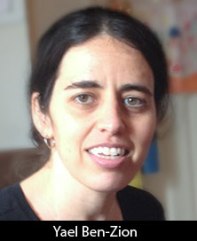 Last week, Ben-Zion took time to talk to The Literate Lens about the project, her aesthetic and her own intermarriage.
Last week, Ben-Zion took time to talk to The Literate Lens about the project, her aesthetic and her own intermarriage.
This project was inspired by a 2009 tv/internet campaign from Israel that cast intermarriage in a very negative light. When the ad came out, you were married and living outside Israel. How did you feel about being characterized as “lost” to Israel because you’d married out of your faith?
I was actually surprised to find out from this advertisement that fifty percent of Jews outside Israel are married to non-Jews; I hadn’t realized that, because intermarriage in Israel is rare. And I understood where it was coming from: there is a fear Judaism will be threatened by too much assimilation. But on a personal level, I felt it was a very blunt frontal attack. The ad was targeting American Jews, trying to reinforce their connection to Israel. But to say “we are losing them” was offending: just because someone is married to a non-Jew doesn’t mean he or she has abandoned Judaism. I believe that was the reason the ad came down after three days.
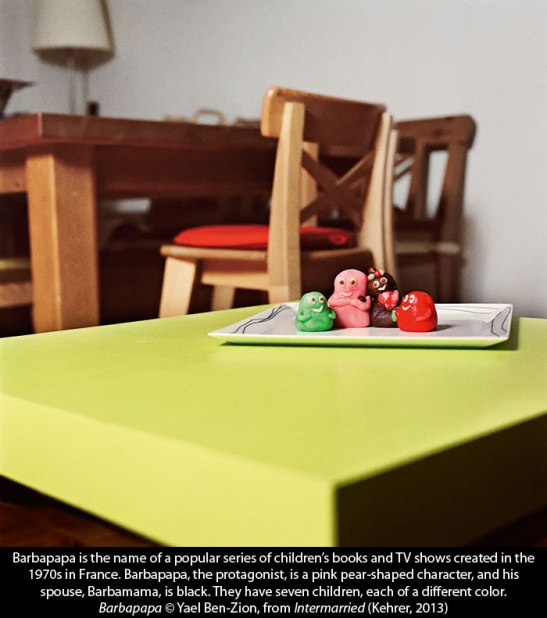 Why is intermarriage so rare in Israel?
Why is intermarriage so rare in Israel?
The only types of marriages allowed within the state of Israel are religious marriages between two people of the same religion. If an Israeli Jew wants to marry an Israeli Muslim or Christian, they have to marry in another country. Then, under private international law, Israel will recognize the marriage. Together with the political situation, this makes it hard to have a mixed marriage.
When you decided to do this project, you advertised on an online parenting forum for your Washington Heights neighborhood. Was there an immediate response?
There was. I put one notice up, and about a year later, I placed a second one. In each wave, there were between five and ten couples interested, and I ended up with more than half of the families each time. From the very beginning, my idea wasn’t to present any kind of survey, so I didn’t look for as many different couples with different features as possible. I was happy to talk to people who wanted to talk to me, and taking into account the personal aspect of the project, I thought the response was good. Everyone who approached me and wanted to be part of the project was able to take part in it.
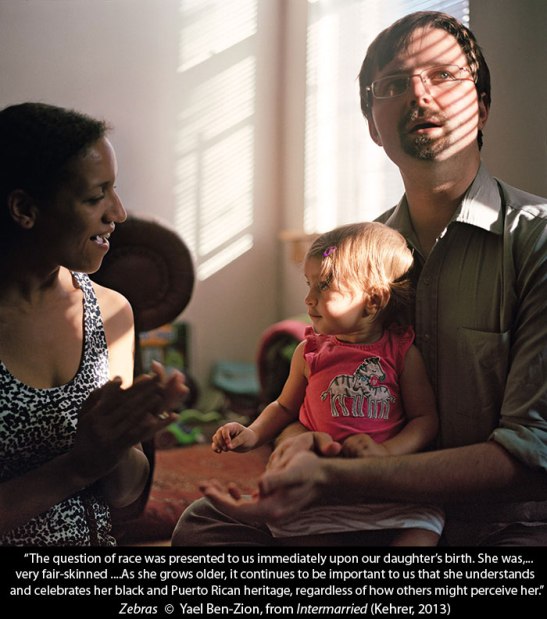 Many of the photographs are very intimate, showing details of the couples’ environments as well as picturing them as people. How did you build the trust needed for that intimacy?
Many of the photographs are very intimate, showing details of the couples’ environments as well as picturing them as people. How did you build the trust needed for that intimacy?
It was a slow process: the project took me four years, on and off, and I usually visited each family a couple of times. People were more open than I expected–by the time they let me into their homes, they’d decided they wanted to be part of the project. It was a process of getting to know them and creating something thought-provoking. Usually in this kind of book you’d expect straight-up portraiture of families, but as I took a different approach there are really no traditional portraits in the book.
In his introduction to the book, Maurice Berger talks about how, in the still life photographs, you use mess as a visual metaphor for the complexity of intermarriage. Was that your intent?
Not exactly, though I’m happy with his take on it. In general, I’d say I don’t like to photograph perfect things; I’m drawn to things that are imperfect. I like photographing objects, and I like mess, though there should be some kind of aesthetic to it. If there’s a picture in the book of objects, or of people’s gestures, it’s because I found symbolic values in it, things that resonated with me. For me, it’s all about nuance and revealing details. We live in an age of instant gratification, but my images reward study. If you only look at them for three seconds, you probably don’t get so much.
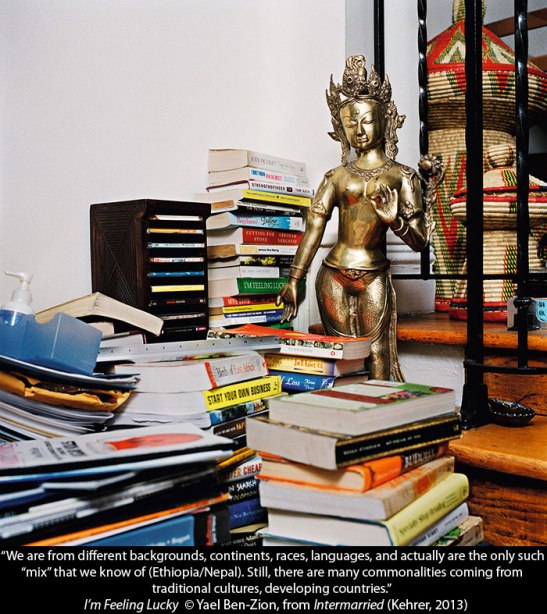 Along with the photographs, you quoted in the book from each couple’s answers to a questionnaire you gave. The answers are really frank and interesting. What kinds of questions did you ask?
Along with the photographs, you quoted in the book from each couple’s answers to a questionnaire you gave. The answers are really frank and interesting. What kinds of questions did you ask?
With each couple, I first sat and asked them a bunch of questions before making any photographs. They were very straightforward questions: Where did you meet? Why do you consider yourselves intermarried? Have you ever felt discriminated against? I told them that later I’d send a formal questionnaire, and that I might use their written answers in the book. The questionnaire was basically a repetition of what I’d asked them in person. All the quotes in the book came from what they wrote. The book is very personal, so I wanted to make sure I used their exact words. Before the book was published, I made sure they were all happy for their words to be used. That was important to me.
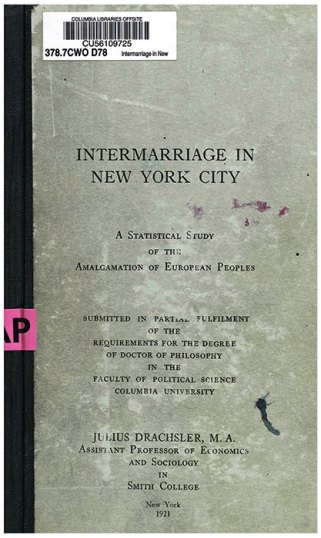 You have other texts in the book too. How did you find the 1921 study on intermarriage that you photographed and quoted from?
You have other texts in the book too. How did you find the 1921 study on intermarriage that you photographed and quoted from?
When I started to look into the subject, I did my research and tried to find studies about intermarriage. This 1921 book was one of the first sociological studies on the subject. It was fascinating to me that the author uses the word “amalgamation” in his title, because in Hebrew you use a similar term for mixed marriage. It’s the same term you use for mixing chemical elements.
One of your subjects is a young woman called Aja. She is not intermarried, but instead is the child of a mixed race marriage. She writes very thoughtfully about the identity issues she’s faced as a mixed race child. How did she get involved?
Aja came to a small exhibition I had in 2012 of some images from the project. We started talking, and she was interested in taking part. She’s the exception, the only adult in the book who represents being a child of intermarriage. I think that including her voice and experiences is necessary; it’s a bit of a reality check. The couples in the book are generally upbeat and positive about the world their children will face, but Aja shows that, as much as things are changing, there are still challenges for children of mixed marriages.
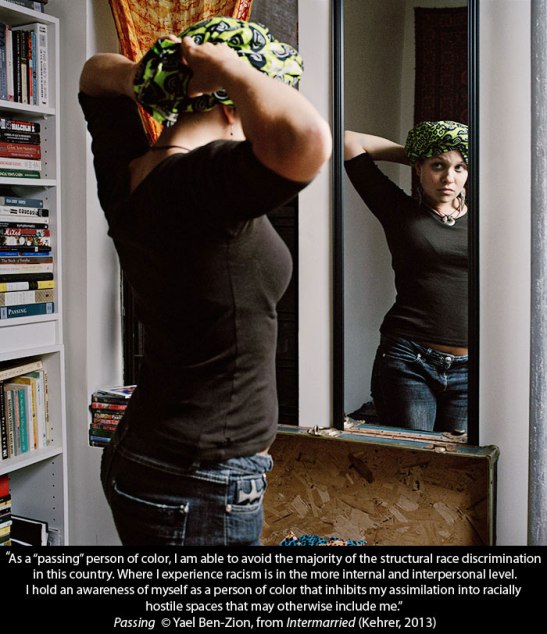 What does intermarriage look like in your household?
What does intermarriage look like in your household?
It’s important to me to instill certain Jewish values in my kids, but it’s more about tradition and customs than about pure religious values. I talk to them in Hebrew, and we celebrate the Jewish holidays. My husband talks to them in French, and we also have a Christmas tree. For my husband, the tree symbolizes something that has nothing to do with religion. I’m fine with that, though I had to overcome the urge to apologize to every Jewish person who enters my home in December!
When you were preparing INTERMARRIED for publication, there was controversy over a television advertisement for Cheerios that featured a mixed race couple. Some people reacted very negatively, some very positively. What did that make you think?
It reinforced my feeling that these issues won’t go away if we don’t talk about them. A lot of these attitudes aren’t even conscious, it’s a question of customs and mindsets that are ingrained. I think it’s interesting that Loving vs. Virginia, the case that abolished miscegenation laws in the United States in 1967, wasn’t really part of the Civil Rights movement. It came a few years later. To me, this shows that you can fight for equal rights, but you can’t force people to be in intimate relationships with someone from another group. And yet, intermarriage has the potential to create real change and a just society, because you gain a deep understanding of people who are different, and not just in the abstract. At the end of the day, it makes you more open.
————————————————-
Yael Ben-Zion’s website is here.
3 comments on “Apples and Oranges: An interview with Yael Ben-Zion”
Leave a Reply
Connecting to %s


Brilliant and thought-provoking article. Thank you Sarah!
I love her photographs. Great interview and insight into the artist’s subject. I am of a Jewish/Christian/Hindu household, and for me none of this was really an issue – religious belief was really left up to each individual, whatever best suited their needs.
I am journeying to Israel for the first time this summer and honestly I know very little about the culture. Ignorant of me, I didn’t realize how conservative people could be religiously in regards to intermarriage 0.o
Thank you for featuring this artist!
You’re welcome, slimcrescentmoon! I, too, did not realize how restricted marriage was in Israel until I interviewed Yael. I hope you enjoy your trip there. I’ve been twice: it’s a fascinating country!